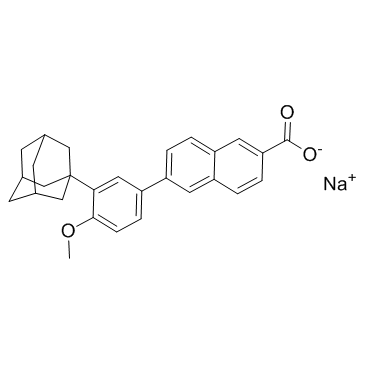Adapalene (sodium salt)
Modify Date: 2024-01-13 18:53:28

Adapalene (sodium salt) structure
|
Common Name | Adapalene (sodium salt) | ||
|---|---|---|---|---|
| CAS Number | 911110-93-5 | Molecular Weight | 434.50 | |
| Density | N/A | Boiling Point | N/A | |
| Molecular Formula | C28H27NaO3 | Melting Point | N/A | |
| MSDS | N/A | Flash Point | N/A | |
Use of Adapalene (sodium salt)Adapalene sodium salt(CD 271; Differin), a synthetic retinoid, is a Retinoic acid receptor agonist (RAR).Target: Retinoic acid receptor agonist (RAR)Adapalene sodium salt is a third-generation topical retinoid primarily used in the treatment of mild-moderate acne and is also used (off-label) to treat keratosis pilaris as well as other skin conditions. Adapalene sodium salt is possibly more effective than tretinoin 0.025% gel in the treatment of acne vulgaris [1].Thirty-six rats of either sex were divided into six groups (two control groups, and an etodolac, indomethacin, tretinoin and adapalene sodium salt group) of six animals each. Each group was given different drugs or chemicals. The inhibitory activities of the drugs were determined on carrageenan-induced rat-paw oedema. The inhibition rate (53.48%) in the tretinoin group was found to be higher than adapalene sodium salt and controls (P < 0.05). Adapalene sodium salt was found to have an inhibition rate of 10.28%, and when compared with the other groups, was found to have no statistically significant anti-inflammatory activity [2].Clinical indications: Acne; Purpura; SunburnFDA Approved Date: 1996Toxicity: Skin redness; dryness; itching; scaling; mild burning |
| Name | 2-Naphthalenecarboxylic acid, 6-(4-methoxy-3-tricyclo[3.3.1.13,7]dec-1-ylphenyl)-, sodium salt |
|---|---|
| Synonym | More Synonyms |
| Description | Adapalene sodium salt(CD 271; Differin), a synthetic retinoid, is a Retinoic acid receptor agonist (RAR).Target: Retinoic acid receptor agonist (RAR)Adapalene sodium salt is a third-generation topical retinoid primarily used in the treatment of mild-moderate acne and is also used (off-label) to treat keratosis pilaris as well as other skin conditions. Adapalene sodium salt is possibly more effective than tretinoin 0.025% gel in the treatment of acne vulgaris [1].Thirty-six rats of either sex were divided into six groups (two control groups, and an etodolac, indomethacin, tretinoin and adapalene sodium salt group) of six animals each. Each group was given different drugs or chemicals. The inhibitory activities of the drugs were determined on carrageenan-induced rat-paw oedema. The inhibition rate (53.48%) in the tretinoin group was found to be higher than adapalene sodium salt and controls (P < 0.05). Adapalene sodium salt was found to have an inhibition rate of 10.28%, and when compared with the other groups, was found to have no statistically significant anti-inflammatory activity [2].Clinical indications: Acne; Purpura; SunburnFDA Approved Date: 1996Toxicity: Skin redness; dryness; itching; scaling; mild burning |
|---|---|
| Related Catalog | |
| References |
| Molecular Formula | C28H27NaO3 |
|---|---|
| Molecular Weight | 434.50 |
| PSA | 46.53000 |
| LogP | 6.68140 |
| Storage condition | 2-8℃ |
| Adapalene (sodium salt) |